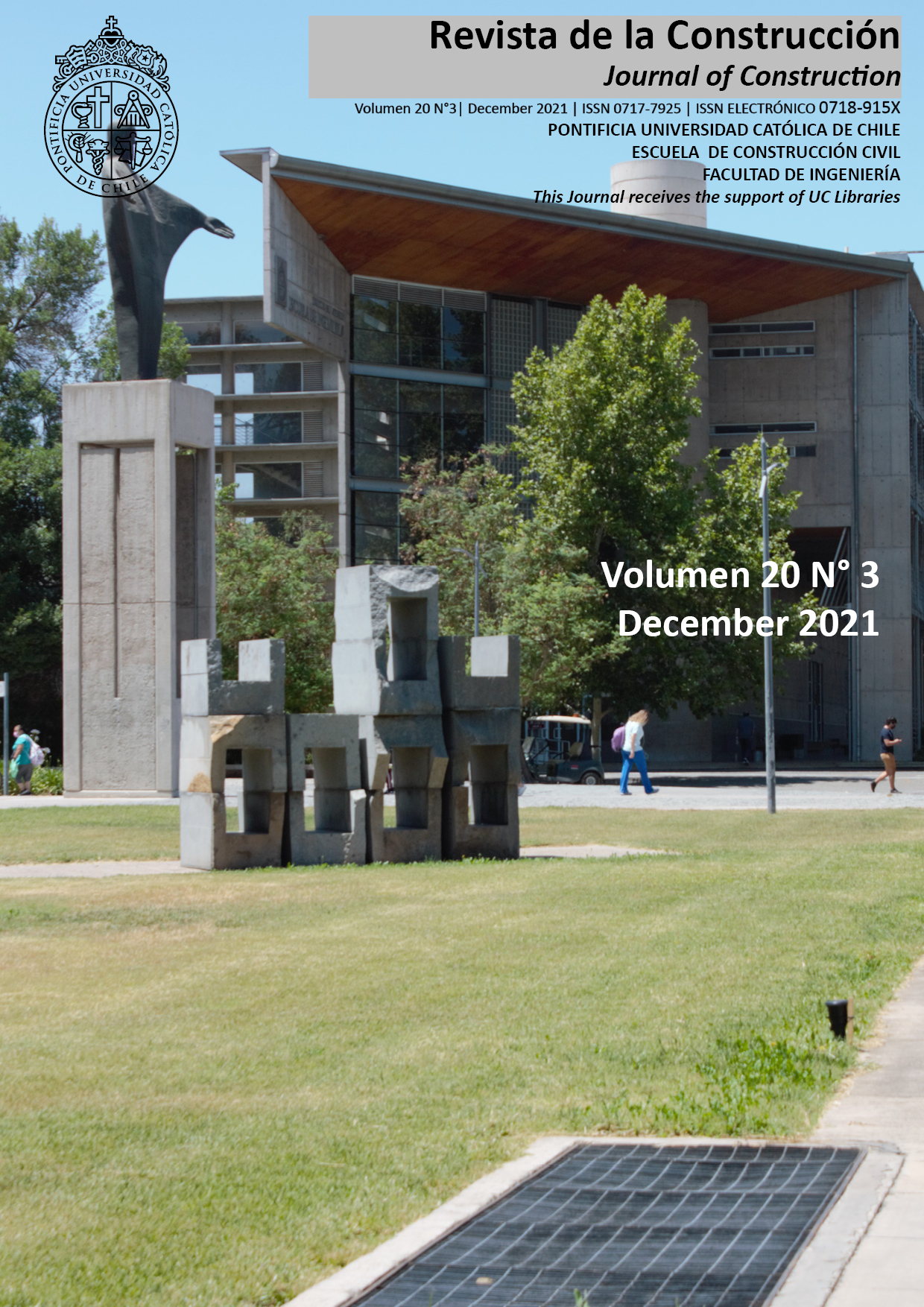Sale price classification models for real estate appraisal
DOI:
https://doi.org/10.7764/RDLC.20.3.440Keywords:
sales price function, discriminant analysis, classification, real estate appraisalAbstract
This study aims to determine the parameters that are effective on sale prices and to obtain the functions that determine the appropriate sale price ranges of real estates. In this context, a total of 138 real estates, which are located in Bayraklı district of Izmir, Turkey and that were for sale between April and June 2019, were investigated. The effects of 17 parameters on the sale price of the real estates were examined through statistical analysis. Thirteen parameters that have been determined to be effective have been used in developing the distinctive functions that decide the sale price ranges of real estates. The results show that parameters such as real estate’s area, age, furniture status, central heating system, playground, pool and gym are statistically significant on the sale price of the real estates. In addition, the functions obtained by using these parameters classified 78.3% of real estate sale prices in the correct range.
Downloads
References
Afşar, A. (2017). Determining The Parameters of Housing Prices Using Hedonic Model: A Case Study in Eskisehir. The Journal of Institute of Social Sciences, (37), 195–205, (in Turkish).
Appraisal Institute. (2015). Standards of Valuation Practice. Chicago: Appraisal Institute. www.appraisalinstitute.org/ professional-practice/ethics-andstandards/standard-of-professionalappraisal-practice/
Atakan, C., & Karabulut, İ. (2003). Discrimination Based on Depth. Selçuk University Journal of Science Faculty, 22, 53–63, (in Turkish).
Ayan, E., & Erkin, H. C. (2014). Hedonic Modeling for a Growing Housing Market: Valuation of Apartments in Complexes. International Journal of Economics and Finance, 6(3), 188–199. doi:10.5539/ijef.v6n3p188
Bhagat, N., Mohokar, A., & Mane, S. (2016). House Price Forecasting using Data Mining. International Journal of Computer Applications, 152(2), 23–26. doi:10.5120/ijca2016911775
Bin, J., Tang, S., Liu, Y., Wang, G., Gardiner, B., Liu, Z., & Li, E. (2017). Regression model for appraisal of real estate using recurrent neural network and boosting tree. 2017 2nd IEEE International Conference on Computational Intelligence and Applications, ICCIA 2017, 2017-Janua, 209–213. doi:10.1109/CIAPP.2017.8167209
Can, A. (1992). Specification and estimation of hedonic housing price models. Regional science and urban economics, 22(3), 453-474.
Cao, K., Diao, M., Wu, B. (2019). A big data-based geographically weighted regression model for public housing prices: a case study in Singapore. Ann. Am. Assoc. Geograph. 109 (1), 173–186.
Chiarazzo, V., Caggiani, L., Marinelli, M., & Ottomanelli, M. (2014). A neural network based model for real estate price estimation considering environ-mental quality of property location. Transportation Research Procedia, 3(July), 810–817. Doi: 10.1016/j.trpro.2014.10.067
Çiçek, U., & Hatırlı, S. A. (2015). Factors Affecting Housing Prices in Isparta Analysis Using Hedonic Price Model. Mehmet Akif Ersoy University Jour-nal of Social Sciences Institute, 7(13), 98–114, (in Turkish).
Daşkıran, I. (2015). Estimation of The Hedonic Pricing Model of Factors Affecting Housing Demand in The City of Denizli. The Journal of International Social Research, 8(37), 850–857, (in Turkish).
Erdem, N. (2017). An Approach for Turkish Real Estate Valuation System. Journal of Geomatics, 2(1), 18–36, (in Turkish).
Ferlan, N., Bastic, M., & Psunder, I. (2017). Influential factors on the market value of residential properties. Engineering Economics, 28(2), 135–144. doi:10.5755/j01.ee.28.2.13777
Kangallı Uyar, S. G., & Yayla, N. (2016). The Estimation Of Housing Prices Within The Frame Of Hedonic Pricing Approach By Spatial Econometric Models: The Case Of Istanbul Housing Market. Social Sciences (NWSASOS), 11(4), 326–342. doi:10.1007/s11187-017-9901-7, (in Turkish).
Koramaz, T. K., & Dokmeci, V. (2012). Spatial Determinants of Housing Price Values in Istanbul. European Planning Studies, 20(7), 1221–1237. doi:10.1080/09654313.2012.673569
Manjula, R., Jain, S., Srivastava, S., & Rajiv Kher, P. (2017). Real estate value prediction using multivariate regression models. IOP Conference Series: Materials Science and Engineering, 263(4), 1–7. doi:10.1088/1757-899X/263/4/042098
Marmolejo-Duarte, C. (2017). Does urban centrality influence residential prices? An analysis for the Barcelona metropolitan area. Revista de La Construc-cion, 16(1), 57–65. doi:10.7764/RDLC.16.1.57
Marmolejo-Duarte, C., & Chen, A. (2019). The evolution of energy efficiency impact on housing prices. An analysis for Metropolitan Barcelona. Revista de La Construccion, 18(1), 156–166. doi:10.7764/RDLC.18.1.156
McLachlan, G. (2004). Discriminant Analysis and Statistical Pattern Recognition. Hoboken, New Jersey: John Wiley & Sons, Inc.
Sahibinden.com. (2019). Retrieved from https://www.sahibinden.com/. (last access: 9 September 2020).
Sarip, A. G., Hafez, M. B., & Nasir Daud, M. (2016). Application of fuzzy regression model for real estate price prediction. Malaysian Journal of Computer Science, 29(1), 15–27. Doi: 10.22452/mjcs.vol29no1.2
SPSS software. (2017). IBM, SPSS Statistics for Windows, Version 25.0. IBM Corp., Armonk.
Uğur, L. O., & Leblebici, N. (2019). Investigation of the effects of energy and water saving benefits on property value in LEED certified green buildings. Technical Journal of Turkish Chamber of Civil Engineers, 30(1), 8753–8776. doi:10.18400/tekderg.312932
Wang, F., Zou, Y., Zhang, H., & Shi, H. (2019). House Price Prediction Approach based on Deep Learning and ARIMA Model. Proceedings of IEEE 7th International Conference on Computer Science and Network Technology, ICCSNT 2019, 303–307. doi:10.1109/ICCSNT47585.2019.8962443
Yayar, R., & Karaca, S. S. (2014). Determining Factors Effecting Housing Prices with Hedonic Model: A Case of TR83 Region. Ege Academic Review, 14(4), 509–509. doi:10.21121/eab.2014418008








